READER COMMENTS ON
"REPORT: Undervote Rate Plummets 85% in New Mexico's Native American Precincts after Statewide Switch from Touch-Screen Voting to Paper Ballots"
(17 Responses so far...)
COMMENT #1 [Permalink]
...
noname
said on 2/26/2007 @ 12:28 pm PT...
Are we going to see petitions to have the DREs removed under the Voting Rights Act?
COMMENT #2 [Permalink]
...
leftisbest
said on 2/26/2007 @ 12:34 pm PT...
I'm sure this is just a fluke. How important was the 2004 election anyway?
Seriously, how much evidence has to be accumulated before someout shouts out "I'm mad as hell and I'm not going to take it anymore!"? (Besides those of us already doing that)
We need massive demonstrations at all statehouses to get rid of these evil machines. Trouble is, it's easier to get an anti-war demonstration going than an anti-e-voting demonstration going.
The public isn't informed b/c MSM still isn't tackling this like the Blogisphere does, and the congress in still weak and wishy washy about kowtowing to Holt.
Is there not ANY legislator who can gather up a clan and get the ban-the-machine movement taken seriously?
COMMENT #3 [Permalink]
...
Brantl
said on 2/26/2007 @ 1:12 pm PT...
I've got a question, why is the 2006 paper ballot undervote about 1.5 to 2 times the 2004 paper ballot undervote across the board? Curious!
COMMENT #4 [Permalink]
...
Ancient
said on 2/26/2007 @ 1:15 pm PT...
God I love hard data! Thanks All.
COMMENT #5 [Permalink]
...
Mark S
said on 2/26/2007 @ 1:22 pm PT...
LEFTISBEST wrote: "Is there not ANY legislator who can gather up a clan and get the ban-the-machine movement taken seriously?"
Um, were you thinking that Republicans were "elected" through rigged elections, but Democrats were "elected" honestly in those same elections?
The military-industrial complex owns the media. They, along with other large corporations, through their donations to the two major parties, get to choose the candidates for both major parties, and the elections industry ensures that the desired pro-war, pro-corporate, anti-impeachment candidate gets "elected." Whether this person is a Democrat or a Republican isn't important, what is important is that they are pro-war, pro-corporate, and anti-impeachment, and that they know that they owe their "election" to the elections industry, not to voters.
You don't have to believe this, LEFTISBEST, but any candidate who was dependent upon votes to get elected, would do everything in their power to ensure that every single vote for them was counted. Have you seen any Democrats or Republicans do that in the past seven years? Some, like Kerry, have promised to, but once they get your money, which is really all they want, they don't care about your vote because the elections industry takes care of the counting and they know that in the event of a dispute, the Supreme Court will step in to prevent a recount, as in Florida 2000.
I was able to predict the Democratic "win" in 2006 after I heard Bill Kristol of PNAC say on national TV that the Democrats would win and that it would be the best thing that could happen for the Republicans. I also predicted that there would be no change. Sombody on BBV just said that there was "some" change, and I replied, "I can't argue with that. There has been some change. You now have more pro-war Democrats than pro-war Republicans in Congress, and more Democrats than Republicans in Congress who oppose impeachment. Congratulations."
I am predicting that a Democratic will "win" the White House in 2008, and that there will be a Democratic majority in both the House and the Senate. I also predict that the first order of business for the new Democratic President will be to issue blanket pardons to Bush, Cheney, and any member of their administration who needs one, which will be followed up by Congressional "investigations" that will be little more than whitewashes and cover-ups. It's an easy prediction to make, as I lived through all this before with Iran-Contra.
There is only one slim chance of this not happening, and that would be if we got rid of all electronic machines, including optical scanners and central tabulators, and went to hand-counted paper ballots at the precincts with full citizen oversight. I'm in San Diego and I could write a book about the problems with optical scanners and central tabulators. But people not as intimately familiar with them will probably have to learn the hard way. Of course if you're very, very good, maybe Congress, Santa Claus, or the Easter Bunny will give you whatever you ask for. Dream on! 
COMMENT #6 [Permalink]
...
DES
said on 2/26/2007 @ 2:19 pm PT...
maybe i'm misunderstanding your question, BrantL #3, but the reason the 2004 undervote rate is soooo very much higher is precisely the point of the entire article: the 2004 vote was done on a touch-screen, NOT on paper ballots. That is why the 2004 undervote rate is exceptionally high and statistically anomalous. NOT because the minorities can't handle a touch-screen voting machine, but because there is copious evidence that the machines failed to record the vote properly at all.
there is no way to conclusively verify the machine's accuracy, even with a paper "trail", whereas with a paper ballot seen by human eyes, there is.
COMMENT #7 [Permalink]
...
TruthIsAll
said on 2/26/2007 @ 3:58 pm PT...
Uncounted and Switched Votes
http://www.geocities.com...ncountedAndSwitchedVotes
Given the Kerry true vote of 66.1 million (based on the 12:22am NEP with feasible weights) and his recorded vote (59.0mm) we can calculate the number of votes which were switched from Kerry to Bush. If we assume that Kerry won 75% (2.6 of 3.4mm) of the uncounted votes based on the Census total of 125.7mm, then 4.5mm (6.8%) of the Kerry vote must have been switched. Furthermore, if we assume that 6.8% of the votes were switched uniformly in each state and allocate the uncounted votes to each state based on population and racial mix, the True Vote Model indicates that Kerry won 336 electoral votes (Sensitivity Analysis I). This result matched the pre-election Monte Carlo Electoral Vote Simulation base case forecast that Kerry would win 337 electoral votes (the average of 5000 election trials). The assumption was that Kerry would win 75% of the undecided vote.
12:22am National Exit Poll
Voted in 2000
Weight Votes Kerry Bush Other
DNV 21.49% 27.02 57% 41% 2%
Gore 38.23% 48.08 91% 8% 1%
Bush 37.83% 47.56 10% 90% 0%
Nader 2.46% 3.09 71% 21% 8%
Total 100% 52.57% 46.43% 1.00%
Votes 125.74 66.10 58.38 1.26
Given:
125.74 million total votes cast (2004 Census)
122.295 million recorded
3.445 million uncounted
Assume:
2.584 million (75%) uncounted votes were for Kerry
95% turnout of Gore and Bush 2000 voters
Calculate:
The number of votes cast for Kerry switched to Bush.
Solution:
True Vote (T) = Recorded (R) + Uncounted (U) + Switched (S)
Solving for S:
S = T - R - U = 66.097 - 59.027 - 2.582 = 4.488mm
Solving for the switched vote rate:
SVR = S / T = 4.488 / 66.097 = 6.79%
True Vote Reconciliation: Uncounted and Switched Votes
Recorded Share Uncounted Switched True Vote
Kerry 59.027 75% 2.584 61.611 4.488 6.79% 66.097 52.57%
Bush 62.040 24% 0.827 62.867 -4.488 -7.69% 58.375 46.43%
Other 1.228 1% 0.034 1.262 0.000 0.00% 1.262 1.01%
Total 122.30 100% 3.445 125.74 0.000 0.00% 125.74 100.0%
SWITCHED VOTE RATE
(sensitivity to Gore and Bush 2000 voter turnout)
Gore Turnout
Bush 91% 92% 93% 94% 95% 96%
Turnout
91% 7.1% 7.4% 7.6% 7.9% 8.1% 8.3%
92% 6.8% 7.1% 7.3% 7.5% 7.8% 8.0%
93% 6.5% 6.7% 7.0% 7.2% 7.4% 7.7%
94% 6.1% 6.4% 6.6% 6.9% 7.1% 7.4%
95% 5.8% 6.1% 6.3% 6.5% 6.8% 7.0%
96% 5.5% 5.7% 6.0% 6.2% 6.5% 6.7%
VOTE DISCREPANCY ASSUMPTIONS
(in thousands)
UNCOUNTED VOTE SHARE
Kerry 75%: 2,582
Bush 24%: 826
Other 1%: 34
Total 100%: 3,443 (2.74% of Census 125.7mm)
SWITCHED VOTES
(in thousands)
4,488 (6.79%) of Kerry Votes were switched to Bush
KERRY VOTE RECONCILIATION
TRUE 66,097 100.0%
Unctd -2,582 3.91%
------ ------- ------
Net 63,515 96.09%
Switch -4,488 6.79%
------ ------- ------
Recorded 59,027 89.30%
EFFECT ON POPULAR AND ELECTORAL VOTE
........Vote......Electoral Vote
Kerry Bush Kerry Bush
Actual 59027 62040 252 286
Change 7070 -3662 97 -97
TRUE 66097 58378 336 202
VOTE 52.57% 46.43%
_________________________________________________________________
BASE CASE SUMMARY
(votes in thousands)
Switched votes: 6.8%
Unctd Share RECORDED UNCOUNTED SWITCHED
Kerry 75% 59027 48.27% 2582 61609 49.0% 2.11% 4488 66097 52.57%
Bush 24% 62040 50.73% 826 62866 50.0% 0.68% -4488 58378 46.43%
Other 1% 1228 1.00% 34 1262 1.0% 0.03% 0 1262 1.00%
Total 2.74% 122295 100% 3442 125737 100% 2.81% 0 125737 100%
SENSITIVITY ANALYSIS I:
Various effects of incremental switched vote rates (SVR)
(75% Kerry share of uncounted votes)
Kerry% Bush Kerry Bush Margin KerryEV BushEV Flipped to Bush
Recorded 48.27% 50.73% 59027 62040 -3013 252 286
SVR
6.8% 52.57% 46.43% 66097 58383 7714 336 202 CO FL IA MO NV NM OH
6.5% 52.42% 46.58% 65906 58570 7336 325 213 CO FL IA NV NM OH
6.0% 52.15% 46.84% 65575 58901 6675 325 213
5.0% 51.63% 47.37% 64914 59562 5353 325 213
4.0% 51.10% 47.90% 64253 60223 4031 325 213
3.0% 50.58% 48.42% 63592 60883 2709 289 249 IA NV NM
2.0% 50.05% 48.95% 62931 61544 1387 289 249
1.0% 49.52% 49.47% 62270 62205 65 264 274 IA NM
0.0% 49.00% 50.00% 61609 62866 -1257 264 274
SENSITIVITY ANALYSIS II:
Effect of incremental uncounted and switched votes on EV
Kerry Electoral Vote
Uncounted Vote Share
50% 55% 60% 65% 70% 75% 80%
SVR
6.8% 325 325 325 325 325 336 336
6.5% 325 325 325 325 325 325 336
6.0% 325 325 325 325 325 325 325
5.0% 298 298 325 325 325 325 325
4.0% 289 289 289 289 289 325 325
3.0% 289 289 289 289 289 289 289
2.0% 264 284 284 284 289 289 289
1.0% 264 264 264 264 264 264 284
0.0% 252 252 252 252 259 264 264
SENSITIVITY ANALYSIS III:
Effect of incremental uncounted and switched votes on vote share
Kerry Vote Share
Uncounted Vote Share
50% 55% 60% 65% 70% 75% 80%
SVR
6.8% 51.89% 52.03% 52.16% 52.30% 52.44% 52.57% 52.71%
6.5% 51.73% 51.87% 52.00% 52.14% 52.28% 52.42% 52.55%
6.0% 51.47% 51.60% 51.74% 51.88% 52.02% 52.15% 52.29%
5.0% 50.94% 51.08% 51.22% 51.35% 51.49% 51.63% 51.76%
4.0% 50.42% 50.55% 50.69% 50.83% 50.96% 51.10% 51.24%
3.0% 49.89% 50.03% 50.16% 50.30% 50.44% 50.58% 50.71%
2.0% 49.36% 49.50% 49.64% 49.78% 49.91% 50.05% 50.19%
1.0% 48.84% 48.98% 49.11% 49.25% 49.39% 49.52% 49.66%
0.0% 48.31% 48.45% 48.59% 48.72% 48.86% 49.00% 49.14%
SENSITIVITY ANALYSIS IV:
Effect of incremental uncounted and switched votes on margin
Kerry Margin (in thousands)
Uncounted Vote Share
50% 55% 60% 65% 70% 75% 80%
SVR
6.8% 6011 6355 6699 7044 7388 7732 8077
6.5% 5614 5958 6303 6647 6991 7336 7680
6.0% 4953 5297 5642 5986 6330 6675 7019
5.0% 3631 3975 4320 4664 5008 5353 5697
4.0% 2309 2654 2998 3342 3686 4031 4375
3.0% 987 1332 1676 2020 2365 2709 3053
2.0% -335 10 354 698 1043 1387 1731
1.0% -1657 -1312 -968 -624 -279 65 409
0.0% -2979 -2634 -2290 -1946 -1601 -1257 -913
COMMENT #8 [Permalink]
...
Ancient
said on 2/26/2007 @ 4:34 pm PT...
Wow TruthIsAll, I'm gonna have to print this page and digest for a while. Thanks!
COMMENT #9 [Permalink]
...
Larry Bergan
said on 2/26/2007 @ 7:56 pm PT...
Thanks for laying waste to the claim that these abominable machines are helping:
Those poor helpless handicapped and minority people.
If infants could vote, they'd be making that case too. They, meaning:
PFAW, MoveOn, Common Cause, The Congress, John Fund ect...
In the rearranged words of Neil Armstrong, it's time to STOP making small steps and START making giant leaps. You know, The way Americans USED TO DO!
COMMENT #10 [Permalink]
...
Charlie L
said on 2/26/2007 @ 11:00 pm PT...
We KNEW New Mexico was stolen on the Reservations.
Oh, and BTW, so did the DEMOCRATIC Governor at the time.
That would be "dark horse" Presidential Candidate Bill Richardson, who did everything in his power to make it look like the 2004 NM election was fair.
COMMENT #11 [Permalink]
...
Charles Wilson
said on 2/27/2007 @ 1:05 am PT...
Your article was unintelligible to me, because it never said what a "DRE" is. Oh well, I guess you're writing for people who already know all the acronyms. I feel like I've walked into a party that started three hours ago, but don't mind me ...
COMMENT #12 [Permalink]
...
Brad Friedman
said on 2/27/2007 @ 1:44 am PT...
Sorry, Charlie. Actually the party started about three years ago. Nonetheless, I do my best to give the backstory just about every time and already overwrite as is.
My apologies for missing this one. I've updated the story to point out that DRE means Direct Recording Elecdtronic, usually touch-screen, voting systems.
Sorry if there weren't enough hints originally to get that point across. Hopefully there is now. Please stay for the rest of the party if you're inclined.
COMMENT #13 [Permalink]
...
Larry Bergan
said on 2/27/2007 @ 4:09 am PT...
Charles Wilson:
You are a victim of the media, not the BradBlog. They call the voting election fraud an of ? thru 2008 an "old story."
COMMENT #14 [Permalink]
...
Mugzi
said on 2/27/2007 @ 5:55 pm PT...
HAVA needs repealing or amending, if they have time! The legislature doesn't have time for impeachment either!
COMMENT #15 [Permalink]
...
anon
said on 2/27/2007 @ 8:35 pm PT...
two answers:
1) I thinkthe undervote is higher in 2006 because no pres race on the ballot. so more people actually chose not to vote for the top ticket race.
2)DRE = Direct Recording Electronic (device) - includes touchscreen and push-button computerized voting stations.
COMMENT #16 [Permalink]
...
Arlene Montemarano
said on 2/28/2007 @ 4:13 am PT...
From:
Original Content at
> http://www.opednews.com/...return_to_sanity__96.htm
..."We are in the midst of what will hopefully be recalled as a very dark period in the history of the United States. Because we're in the middle of it and because the corporate press has ceased to function as the independent watchdog the Constitution intended, the majority of people don't know we are now forced to vote on machines which can readily steal and have stolen our votes. ".........
COMMENT #17 [Permalink]
...
Jeremy
said on 2/28/2007 @ 5:25 am PT...
Just a reminder:
RFK Jr:
In New Mexico, which was decided by 5,988 votes, malfunctioning machines mysteriously failed to properly register a presidential vote on more than 20,000 ballots.
 "We were looking for any impact the change to paper ballots may have had on New Mexico’s historically high undervote rate. When we found the dramatic drop in Native American precincts, we were shocked," says New Mexico's Theron Horton. The Election Defense Alliance (EDA) activist added, "something was going on with the DREs in those precincts in 2004."
"We were looking for any impact the change to paper ballots may have had on New Mexico’s historically high undervote rate. When we found the dramatic drop in Native American precincts, we were shocked," says New Mexico's Theron Horton. The Election Defense Alliance (EDA) activist added, "something was going on with the DREs in those precincts in 2004."

 Campaign to 'Impeach Trump Again' Gains Fresh Momentum: 'BradCast' 4/29/25
Campaign to 'Impeach Trump Again' Gains Fresh Momentum: 'BradCast' 4/29/25 'Green News Report' 4/29/25
'Green News Report' 4/29/25
 And Then They Came for the Judges...: 'BradCast' 4/28/25
And Then They Came for the Judges...: 'BradCast' 4/28/25 Sunday 'Desperation' Toons
Sunday 'Desperation' Toons Trump EPA Guts Enviro Justice Office: 'BradCast' 4/24/25
Trump EPA Guts Enviro Justice Office: 'BradCast' 4/24/25 'Green News Report' 4/24/25
'Green News Report' 4/24/25 Nation's Largest Broadcaster Hoaxes Viewers to Help Gut FCC Rules: 'BradCast' 4/23/25
Nation's Largest Broadcaster Hoaxes Viewers to Help Gut FCC Rules: 'BradCast' 4/23/25 Trump's FCC on Precipice of Ending All Limits on Corporate Control of Local TV Stations
Trump's FCC on Precipice of Ending All Limits on Corporate Control of Local TV Stations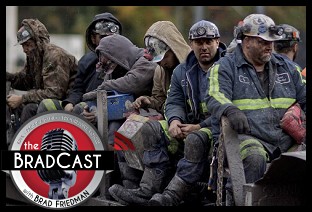 GOP Earth Day 2025 Hypocrisies and Dilemmas: 'BradCast' 4/22/25
GOP Earth Day 2025 Hypocrisies and Dilemmas: 'BradCast' 4/22/25 'Green News Report' 4/22/25
'Green News Report' 4/22/25 Pope Francis Dies, Trump Still Alive and Criming: 'BradCast' 4/21/25
Pope Francis Dies, Trump Still Alive and Criming: 'BradCast' 4/21/25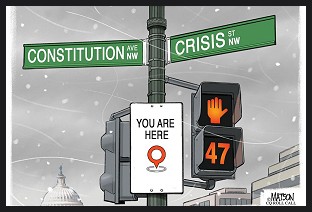 Sunday
Sunday  Sunday 'Zero Day' Toons
Sunday 'Zero Day' Toons 'Green News Report' 4/10/25
'Green News Report' 4/10/25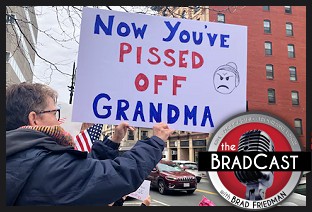 Soc. Sec. Expert Warns DOGE of Collapse, Privatization: 'BradCast' 4/10/2025
Soc. Sec. Expert Warns DOGE of Collapse, Privatization: 'BradCast' 4/10/2025 Trump Blinks, Chaos Reigns, Markets Spike Amid Tariff 'Pause': 'BradCast' 4/9/25
Trump Blinks, Chaos Reigns, Markets Spike Amid Tariff 'Pause': 'BradCast' 4/9/25 SCOTUS Deportation Ruling Grimmer Than First Appears: 'BradCast' 4/8/25
SCOTUS Deportation Ruling Grimmer Than First Appears: 'BradCast' 4/8/25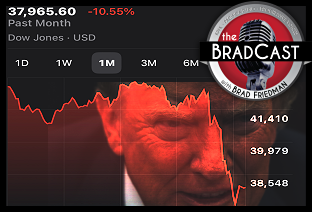 Cliff Diving with Donald: 'BradCast' 4/7/25
Cliff Diving with Donald: 'BradCast' 4/7/25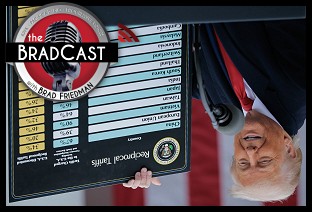 'Mob Boss' Trump's Trade Sanctions Tank U.S., World Markets: 'BradCast' 4/3/25
'Mob Boss' Trump's Trade Sanctions Tank U.S., World Markets: 'BradCast' 4/3/25 Crawford Landslide in WI; Booker Makes History in U.S. Senate: 'BradCast' 4/2/25
Crawford Landslide in WI; Booker Makes History in U.S. Senate: 'BradCast' 4/2/25 Judge Ends Challenge to GA's Unverifiable, Insecure Vote System: 'BradCast' 4/1/25
Judge Ends Challenge to GA's Unverifiable, Insecure Vote System: 'BradCast' 4/1/25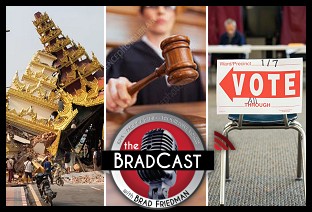 Bad Court, Election News for Trump is Good News for U.S.: 'BradCast' 3/31
Bad Court, Election News for Trump is Good News for U.S.: 'BradCast' 3/31
 VA GOP VOTER REG FRAUDSTER OFF HOOK
VA GOP VOTER REG FRAUDSTER OFF HOOK Criminal GOP Voter Registration Fraud Probe Expanding in VA
Criminal GOP Voter Registration Fraud Probe Expanding in VA DOJ PROBE SOUGHT AFTER VA ARREST
DOJ PROBE SOUGHT AFTER VA ARREST Arrest in VA: GOP Voter Reg Scandal Widens
Arrest in VA: GOP Voter Reg Scandal Widens ALL TOGETHER: ROVE, SPROUL, KOCHS, RNC
ALL TOGETHER: ROVE, SPROUL, KOCHS, RNC LATimes: RNC's 'Fired' Sproul Working for Repubs in 'as Many as 30 States'
LATimes: RNC's 'Fired' Sproul Working for Repubs in 'as Many as 30 States' 'Fired' Sproul Group 'Cloned', Still Working for Republicans in At Least 10 States
'Fired' Sproul Group 'Cloned', Still Working for Republicans in At Least 10 States FINALLY: FOX ON GOP REG FRAUD SCANDAL
FINALLY: FOX ON GOP REG FRAUD SCANDAL COLORADO FOLLOWS FLORIDA WITH GOP CRIMINAL INVESTIGATION
COLORADO FOLLOWS FLORIDA WITH GOP CRIMINAL INVESTIGATION CRIMINAL PROBE LAUNCHED INTO GOP VOTER REGISTRATION FRAUD SCANDAL IN FL
CRIMINAL PROBE LAUNCHED INTO GOP VOTER REGISTRATION FRAUD SCANDAL IN FL Brad Breaks PA Photo ID & GOP Registration Fraud Scandal News on Hartmann TV
Brad Breaks PA Photo ID & GOP Registration Fraud Scandal News on Hartmann TV  CAUGHT ON TAPE: COORDINATED NATIONWIDE GOP VOTER REG SCAM
CAUGHT ON TAPE: COORDINATED NATIONWIDE GOP VOTER REG SCAM CRIMINAL ELECTION FRAUD COMPLAINT FILED AGAINST GOP 'FRAUD' FIRM
CRIMINAL ELECTION FRAUD COMPLAINT FILED AGAINST GOP 'FRAUD' FIRM RICK SCOTT GETS ROLLED IN GOP REGISTRATION FRAUD SCANDAL
RICK SCOTT GETS ROLLED IN GOP REGISTRATION FRAUD SCANDAL VIDEO: Brad Breaks GOP Reg Fraud Scandal on Hartmann TV
VIDEO: Brad Breaks GOP Reg Fraud Scandal on Hartmann TV RNC FIRES NATIONAL VOTER REGISTRATION FIRM FOR FRAUD
RNC FIRES NATIONAL VOTER REGISTRATION FIRM FOR FRAUD EXCLUSIVE: Intvw w/ FL Official Who First Discovered GOP Reg Fraud
EXCLUSIVE: Intvw w/ FL Official Who First Discovered GOP Reg Fraud GOP REGISTRATION FRAUD FOUND IN FL
GOP REGISTRATION FRAUD FOUND IN FL



































